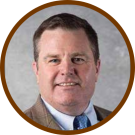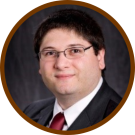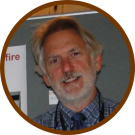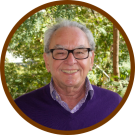Meet the friendly faces of the technical program committee! These individuals have been hard at work for the past year developing the structure and content of the inaugural WiReS conference program.

Alex Maranghides
National Institute of Standards and Technology (NIST), Wildland Urban Interface Fire Group Fire Protection Engineer
Mr. Maranghides has received a B.S. Mechanical Engineering with Aerospace Concentration, and an M.S. in Fire Protection Engineering, both from Worcester Polytechnic Institute, in Worcester, Massachusetts. Mr Maranghides has over 25 years’ experience in large scale testing and 20 years in post fire reconstructions.
Mr. Maranghides has worked for 7 years at the US Naval Research Laboratory (NRL), on the Navy's Halon Replacement Program. Between 1995 and 2000 Mr. Maranghides was the Test Director for NRL Real Scale Halon Replacement Test Program where he worked on the development of a holistic approach to halon replacement fire protection system design. In that capacity he analyzed current US Navy Fleet fire suppression system design criteria and firefighting doctrine. He is the co-inventor, with Dr. Ronald Sheinson of NRL, of the Water Spray Cooling System (WSCS), a patented gaseous agent suppression enhancing system used to protect shipboard compartments in Navies around the world.
After joining NIST, Mr. Maranghides run the NIST Large Fire Laboratory for seven years where he was responsible for the design and execution of hundreds of large-scale experiments. In the past twenty years, Mr. Maranghides has focused his research on the national Wildland Interface (WUI) Fire problem. He has spent years in the field collecting, analyzing and documenting WUI fires and had led all four NIST WUI Fire reconstructions. His WUI findings have impacted national and regional standards. He is currently leading a multiyear/ multiagency effort to quantify fire spread between residential structures.
His technical fields of expertise include halon replacements, fire suppression, large scale fire testing and the wildland urban interface.

Bryan Cordill
Propane Education and Research Council, Director of Residential and Commercial Business Development
Bryan Cordill is the director of residential and commercial business development at the Propane Education & Research Council.

Dr. Carlos Martin
Harvard Joint Center for Housing Studies, Director of the Remodeling Futures Program
Carlos Martín is Project Director of the Remodeling Futures Program, and has over 25 years of experience researching housing technology and the physical quality of existing homes. Dr. Martín's research on green housing, disaster mitigation and recovery, substandard housing, construction innovation, and the construction workforce connects the bricks-and-mortar of existing housing to its social outcomes. Carlos came to the Center from the Urban Institute, where he was a senior fellow. Previously, he was an assistant staff vice president for construction codes and standards at the National Association of Home Builders, SRP professor for energy and the environment at Arizona State University, and coordinator for the US Department of Housing and Urban Development's Partnership for Advancing Technology in Housing. Carlos is currently serving as a David M. Rubenstein Fellow at the Brookings Institution's Metropolitan Policy Program and also serves on several National Academy of Science committees. He has previously served on advisory boards for HUD, EPA, and FEMA. Carlos received his BSAD in architecture from the Massachusetts Institute of Technology and his MEng and PhD degrees in civil and environmental engineering from Stanford University.

Dr. Catherine Brinkley
Center for Regional Change, Director
UC Davis, Assistant Professor
Dr. Catherine Brinkley is an Associate Professor in Human Ecology, Community and Regional Development in the College of Agricultural and Environmental Sciences. With a PhD in city and regional planning, a veterinary medical degree, and a masters in virology, her research focuses on health and design. She is a former Fulbright Scholar, Watson Fellow, and National Science Foundation Career Award Winner.
She has published on topics such as healthy food systems, local government planning and decision-making, and sustainable development. Dr. Brinkley currently serves as Director for the Center for Regional Change, a university research center that partners with local governments and non-profits for engaged scholarship that centers social equity. Her work is used internationally by the United National Food Agriculture Organization as well as local communities to guide plans and policies.

Dan Turner
California Polytechnic State University, Director of WUI FIRE Institute
Dan Turner had an esteemed career with the California Department of Forestry and Fire Protection (Cal Fire) before retiring in 2006 with more than 37 years of service. Today he works at Cal Poly, establishing the Wildland-Urban Interface Fire Institute. He also serves as the manager of the San Luis Obispo County Fire Safe Council and is well respected throughout the state as an authority on fire.

Kate Dargan
Intterra, Founder
Retired Fire Marshal
Kate Dargan has been a firefighter, fire chief and the former State Fire Marshal (CAL FIRE) for California. She has responded to emergencies and disasters around the state and worked on boards, committees, councils, and task forces to advance wildland-urban interface fire safety. She chaired the State Board of Fire Services, chaired the Tahoe Fire Commission, served on the Napa County Watershed Board, and is a Board Member of the CA Firesafe Council and the United States Geospatial Intelligence Foundation. She has worked at the community, public agency, industry, and policy levels of the California fire service and is widely recognized for her consensus building style and innovative approaches to old problems. She founded and co-owns, Intterra, a geospatial situational awareness and analytics company that specializes in software for firefighters.

Dr. Marcelo Hirschler
GBH International, President
Marcelo Hirschler has many years of experience with fire safety issues. For example, by providing technical assistance with codes and standards issues (emphasis on fire), as well as consulting services for fire-related legal cases.
Dr. Hirschler has a strong background in fire performance of plastics (such as PVC or foam plastics) and the effects of flame retardants and has published almost 500 papers and six books. He is very active on proposals for development and amendment of codes (leading to regulation), including the building codes (IBC and NFPA 5000), the life safety code (NFPA 101), the national electrical code (NEC, NFPA 70), the mechanical codes (IMC, UMC), the fire codes (IFC, NFPA 1), the residential code (IRC) and the wildland code (IWUIC).
Furthermore, Marcelo Hirschler is very active in the development of standard fire tests, practices, specifications and guides (nationally and internationally) within ASTM, NFPA, CSA, ISO and IEEE. In addition, Dr. Hirschler has been appointed to a number of positions of responsibility within codes and standards committees and has received several awards. He was appointed by ICC to the IBC Fire Safety committee for 3 code development cycles.

Michele Barbato - Conference Chair
UC Davis Climate Adaptation Research Center, Co-Director
CITRIS and the Banatao Institute, Director of CITRIS Climate Initiative
Dr. Michele Barbato is a Professor in the Department of Civil & Environmental Engineering at the University of California, Davis. He is also co-director and co-founder of the UC Davis Climate Adaptation Research Center, and director of the CITRIS Climate Initiative of the CITRIS and the Banatao Institute. He received his Summa Cum Laude “Laurea” degree in Civil Engineering from the Sapienza University of Rome (Rome, Italy) in 2002, and his M.S. and Ph.D. in Structural Engineering in 2005 and 2007, respectively, at the University of California, San Diego. He is a licensed PE in Louisiana and in Italy.
Dr. Barbato is an expert in both traditional and innovative construction methodologies and materials, with particular emphasis on new recycled and green materials. His research includes modeling, analysis, and design of structural and infrastructure systems subject to earthquake, wind, storm surge, and wildfire hazards. He is active in the development of performance-based methodologies in earthquake, wind, and hurricane engineering, as well as in multihazard applications. Dr. Barbato’s research also embraces nonlinear finite element modeling and analysis of structural systems, random vibration theory, structural reliability analysis, multihazard assessment and mitigation under current and changing climate conditions, and life-cycle cost optimization of resilient/sustainable structures subject to multiple hazards. Dr. Barbato’s research aims to develop safer, economic, and more rational design procedures, accounting for natural and man-made hazards, which support the development of sustainable infrastructures and more resilient communities under current and changing climate conditions.
He is the author of more than 200 technical publications. He received the 2007 ICASP10 Overseas Student Scholarship, the 2009 ASCE Moisseiff award, the 2011 European Association of Structural Dynamics Junior Research Prize, the ISSE-12 Best Paper Award for Young Experts, the 2020 ASCE Sacramento Section Fredrick Panhost Structural Engineer Award, and the 2020 Walter L. Huber Civil Engineering Research Prize, as well as several teaching and service awards. He was elected SEI Fellow and EMI Fellow in 2019, and ASCE Fellow in 2021. Dr. Barbato has served as the Chair of the ASCE EMI Dynamics Committee in 2017-2020 and of the ASCE SEI Multihazard Mitigation Committee in 2018-2021, and is currently the Chair of the ASCE SEI Performance Based Design of Structures Committee, an associate member of the ASCE 7-22 Wind Loads Subcommittee, and a member of the EMI Board of Governors. He is an associate editor of the ASCE Journal of Architectural Engineering, ASCE Natural Hazards Review, ASCE-ASME Journal of Risk and Uncertainty in Engineering Systems: Part A-Civil Engineering and Part B-Mechanical Engineering, and the specialty editor in Earthquake Engineering and Structural Engineering for the Journal of Research on Engineering Structures and Materials.

Molly Mowery
Community Wildfire Planning Center (CWPC), Executive Director
Molly Mowery, AICP is Executive Director for the non-profit organization Community Wildfire Planning Center and founder of Wildfire Planning International. For more than 15 years, Molly has been a pioneer in integrating wildfire hazard mitigation with land use planning practices. Molly has developed land use planning programs and trainings, including wildland-urban interface planning courses for FEMA and CAL FIRE, and served as the lead author of the American Planning Association publication Planning the Wildland-Urban Interface. Molly has worked with communities across the U.S. and Canada, and drafted land use planning guidance for the National Research Council of Canada’s National Guide for Wildland-Urban interface Fires. Molly frequently presents on wildfire planning topics and provided the Norman Williams Distinguished Lecture in Land Use Planning and Law hosted by the Vermont Law School in 2021. She is a certified planner with the American Institute of Certified Planners and chair-elect of the APA Hazard Mitigation and Disaster Recovery Division. Molly earned a bachelor of arts from Naropa University (Boulder, CO) and a master in city planning from the Massachusetts Institute of Technology (Cambridge, MA).

Nicholas Bartlett
Berkeley Lab, Senior Fire Protection Engineer
Experience in testing and certification of fire suppression equipment with Underwriters Laboratories. Masters degree in fire safety engineering in joint program in Europe with on-campus studies at the University of Edinburgh, Ghent University, and Lund University. Masters thesis on smoke control in underground subway station, utilizing FDS and FDS+Evac. Experience in Fire Engineering Consulting at Hughes Associates. Smoke control design and review, smoke control commissioning work, FDS/CFast work, fire hazard analysis, code consulting, miscellaneous site visits and inspections, and more. Currently Fire Protection Engineer and Fire Inspector at Lawrence Berkeley National Laboratory. Responsible for fire/life safety plan reviews and fire/building inspections for new construction and tenant improvements, fire inspections for 50+ buildings, conducting Fire Hazard Analysis in accordance with DOE requirements, partake in emergency response operations in conjunction with LBNL emergency response organization and Alameda County Fire Department, interface with inspection, testing, and maintenance as it relates to fire/life safety, conduct NFPA 921 fire investigations when fires occur, develop and implement all fire prevention policy, wildland fire management and prevention, public education and speaking related to fire prevention and fire safety engineering.

Steve Quarles
UC Cooperative Extension, UCCE Advisor Emeritus
Retired Chief Wildfire Scientist at IBHS
Stephen Quarles is an expert on how building materials perform and how different building designs fare in wildfires.
His route to studying structures in wildfires started in the late 1990s. The University of California Forest Products Lab received a FEMA grant to study materials and building design and develop testing protocols that could be used by the California Office of the State Fire Marshal. Steve was the project manager. He studied the durability and performance of wood-frame buildings and focused on the exterior-use building materials, components and assemblies subjected to wildfire exposures.
After 26 years with the University of California, Steve joined the Insurance Institute for Business & Home Safety (IBHS) in 2011 as a senior scientist. His research and outreach focuses on wildfire protection for residential and light commercial buildings and improving the moisture-related durability and resilience of buildings following hurricane/high-wind events. He is the South Carolina Wind and Hail Underwriting Association Hazard Resilience Chair at the Research Center.
Steve earned a bachelor’s in wood science from Virginia Tech, and a master’s and a doctorate in wood science from the University of Minnesota. He worked for Weyerhaeuser in southern Georgia for several years. Steve is a member of the American Society of Testing and Materials (ASTM) where he is secretary for and task group chair in the E05.14 Subcommittee on Exterior Fire; the Forest Products Society, where it is Editor in Chief of the Forest Products Journal; the Society of Wood Science and Technology; the National Fire Protection Association, where he is a member of the Technical Committee on Forest and Rural Fire Protection; the International Association of Wildland Fire and the American Wood Protection Association.
Specialties: Performance of buildings exposed to wildland fire. Expertise in effectiveness of mitigation strategies.

Steve Hawks
California Department of Forestry and Fire Protection, Staff Chief - Wildfire Planning & Engineering Division
Chief Hawks has served since 1989 with the California Department of Forestry and Fire Protection (CAL FIRE). He has promoted through the ranks from firefighter to his current position as Acting Assistant Deputy Director of CAL FIRE’s Community Wildfire Preparedness and Mitigation, and Fire Engineering and Investigation Divisions. Chief Hawks has been involved with several teaching cadres, served for 13 years on different CAL FIRE Incident Management Teams, and holds a Bachelor of Science Degree in Forest Resource Management with a minor in Business Administration from Humboldt State University.

William Siembieda
California Polytechnic State University, Professor
William Siembieda, is Professor Emeritus of City and Regional Planning at California Polytechnic State University, San Luis Obispo.
Dr. Siembieda brings a city planning perspective to the study of resiliency, risk reduction and hazard mitigation; and a policy focus on how to best integrate informed choices in the construction of resilient and reduced risk communities.
His professional practice efforts linked to the hazard and risk reduction are transnational including being a subject matter expert to the World Bank, the Asian Development Bank, the Chilean National Center for Integrated Natural Hazard Management, and the Japanese International Cooperation Agency.
In California he was a co-director of the State of California Multi-Hazard Mitigation Plan that integrates an enormous range of state agency efforts under a common vision, and won national acclaim for early inclusion of climate adaptation. The plan was so well received by State officials that the Cal Poly team was asked to update three more times ( 2018, 2013, 2010, 2007). He is a national expert on State Hazard Mitigation Plan preparation, as well as contributing to the State of California Adaptation Planning Guide 1.0, which was five years ahead of its time and at the forefront of the local adaptation practice. Since 2020 he serves as advisor to the County of Santa Barbara, CA Core Team for its Climate Changes Vulnerability Assessment, and At Cal Poly is a Principal Faculty Researcher working to establish the Wildland Urban Interface (WUI) Fire Institute.
His reputation for understanding the dynamics of disaster and recovery systems has been recognized by being asked to lead the planning and policy group in the Earthquake Engineering Research Institute’s (EERI) Field Team to Chile in 2010, the Geotechnical Extreme Events Reconnaissance (GEER) team in New Zealand in 2014, and participant in the Harvard University Kennedy School of Government Center for Crisis Leadership program on major issues in disaster recovery, 2016.
This evolution in his knowledge is based on decades of research and practice. In 2000, he assembled a Cal Poly student team that developed a resettlement plan in Honduras for 20,000 people (Amarateca Valley Plan). This was the first land use plan in Central America that utilized a sustainability design approach that conserved resources and lowered future disaster natural hazard risk. Again, including students, he led the design of an Environmental Management Plan to protect the Mayan City of Copan, a UN World Heritage site: As a member of a Japanese support team, he led the vision and goal setting work for the Federal District of Caracas Disaster Preparedness and Mitigation Plan, the first of its kind in Latin America.